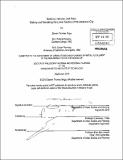Bottoms, Hollows, and Flats : making and remaking the lower section of the American city
Author(s)
Moga, Steven Thomas
DownloadFull printable version (56.09Mb)
Other Contributors
Massachusetts Institute of Technology. Dept. of Urban Studies and Planning.
Advisor
Lawrence J. Vale.
Terms of use
Metadata
Show full item recordAbstract
This dissertation is an urban environmental history of the low-lying American slum. Using qualitative research methods, I investigate the historical phenomenon of topographically based, socio-economic segregation in cities, and how urban actors first created these places then remade them. I examine six low-lying urban neighborhoods in the United States: "The Bottoms" in Columbus, Ohio; "Frog Hollow" in Hartford, Connecticut; "The Flats" in Los Angeles, California; "Black Bottom" in Nashville, Tennessee; "Swede Hollow" in St. Paul, Minnesota; and, "Foggy Bottom" in Washington, D.C. The first part of the thesis examines how land and factory owners, real estate developers, and speculators made urban lowlands into residential districts nicknamed bottoms, hollows, and flats beginning in the late nineteenth century. I argue that the deliberately incomplete implementation of urban interventions such as sewerage, water supply, and flood protection created interstitial spaces for stigmatized residence. Considered potentially threatening strangers, foreign immigrants, black migrants, and poor country whites were forced down into the lowlands, which functioned as containment zones within the internal structure of the city. The second part of the thesis details three modes of remaking the lowlands: slum clearance, zoning, and big projects. Late nineteenth century attempts to remove residents and eliminate slums encountered resistance from voters and city officials due to concerns that displaced undesirables would move into their city spaces. By the 1920s, zoning helped to ease middle and upper class fears of invasion by promulgating rules to protect neighborhoods of single-family homes. After 1937, the federal government funded resident removal and physical redevelopment through public housing, highways, and the urban renewal program, erasing the old lowland slums. The history of urban lowlands highlights the low-lying landscape as an urban nexus point, revealing an inherent conflict between urban actors over containment of the poor versus the redevelopment of stigmatized districts. Planners intervene in this conflict, and assist in the repeated remaking of desirable and undesirable city spaces. The thesis draws connections among physical planning, social inequality, natural processes, and urban space in lowlands of unique interest to scholars and practicing planners in an era of renewed interest in the environment of cities.
Description
Thesis (Ph. D.)--Massachusetts Institute of Technology, Dept. of Urban Studies and Planning, 2010. Cataloged from PDF version of thesis. Includes bibliographical references (p. 316-331).
Date issued
2010Department
Massachusetts Institute of Technology. Department of Urban Studies and PlanningPublisher
Massachusetts Institute of Technology
Keywords
Urban Studies and Planning.